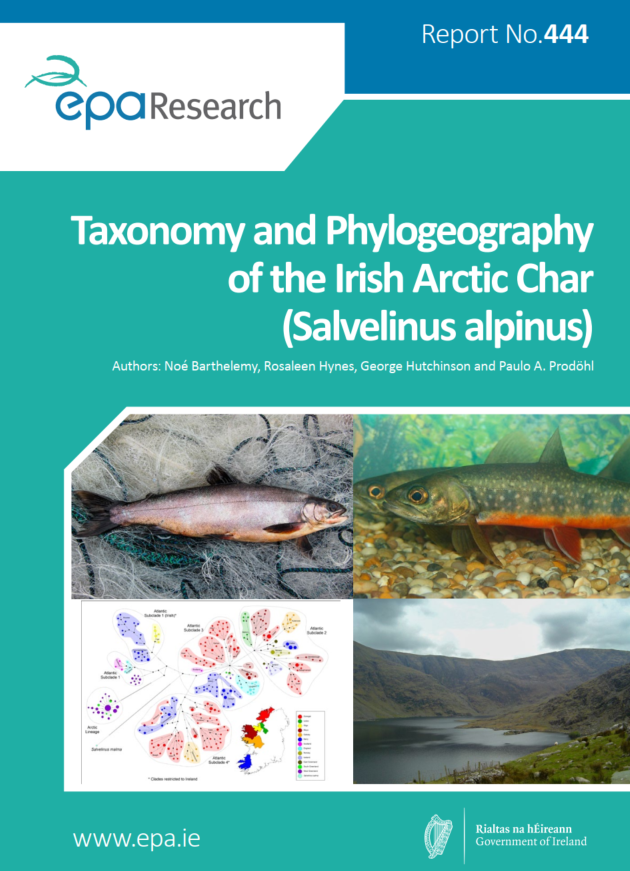Authors: Noé Barthelemy, Rosaleen Hynes, George Hutchinson and Paulo A. Prodöhl
Summary: Salmonid Arctic char is a freshwater fish species vulnerable to low oxygen levels, rising temperatures associated with global warming, threats from invasive species, and water abstraction activities. There is an urgent need for effective conservation and management of Irish Arctic char, as it is recognised as “vulnerable” in the Irish Red Data Book. The study examined the role of scientific communication in influencing policymakers' decisions on conservation of this species.

This research focuses on the conservation and management of the endemic salmonid Arctic char (Salvelinus alpinus) in Irish loughs, a species vulnerable to low oxygen levels, rising temperatures associated with global warming, threats from invasive species, and water abstraction activities. There is an urgent need for effective conservation and management of Irish Arctic char, as it is recognised as “vulnerable” in the Irish Red Data Book. The study aims to clarify their taxonomic status in Ireland, investigating whether there is scientific evidence supporting the existence of multiple species in different loughs, which is vital for protecting their unique biodiversity. It also explores the phylogeographical origins and population genetic structure of the species in Ireland, which is key to informing targeted conservation strategies to preserve their genetic diversity and unique populations. Finally, the study examines the role of scientific communication in influencing policymakers’ decisions on conservation, a crucial factor considering Arctic char’s sensitivity to environmental changes and their significance as indicators of climate change and ecosystem health.
This research on Irish Arctic char provides a sound scientific foundation for their conservation. It challenges the species status of Arctic char populations based on Victorian-era taxonomy, thus enhancing public understanding and support for protecting unique genetic diversity and populations. Although the study found no genetic or morphometric evidence for the presence of multiple Arctic char species in Ireland, it highlighted the distinctiveness and richness of the Irish Arctic char’s genetic diversity, which has evolved in relative isolation since the Last Glacial Maximum. Remarkably, two of the four Arctic char genetic lineages identified are thought to be restricted to Ireland. The study also highlights how uncertainties in the conservation context can significantly affect policy decisions, emphasising the importance of well-informed conservation strategies. A key outcome is the development of a prioritisation list for Arctic char conservation that incorporates genetic and morphometric data along with other relevant information. This list serves as a practical guide for stakeholders, facilitating the implementation of effective conservation measures. In summary, the study’s insights contribute to more informed, effective conservation practices for Irish Arctic char, with broader implications for global biodiversity conservation.
This study’s distinctiveness lies in its comprehensive approach to understanding the genetic and morphometric diversity of Arctic char populations in Ireland. It analysed over 3200 specimens, including museum samples from the 1800s and 1900s, covering 82% of the loughs where the species has been recorded as naturally present, including those where it is now presumed extinct. Using modern genetic tools, including single nucleotide polymorphism (SNP) markers for both nuclear and mitochondrial DNA (mtDNA), along with complete sequencing of Arctic char mtDNA genomes, the research provided an in-depth examination of the species’ genetic composition across various loughs in Ireland. Challenging previous views, the study proposes that Ireland’s Arctic char populations do not represent multiple species. Instead, it reveals four distinct genetic lineages of a single species, with considerable mtDNA diversity, two of which might be exclusive to Ireland. This diversity, having evolved in isolation since the Last Glacial Maximum, emphasises the need to manage its preservation. The study recommends revising the species status of Arctic char, focusing on their unique genetic lineages rather than classifying them into different species. It also advocates for the further development and use of a prioritisation list for conservation needs in Ireland, based on genetic and morphometric data, alongside other lough information. This list is intended to guide effective conservation strategies. Overall, the study calls for tailored conservation efforts, underpinned by extensive genetic data, to safeguard the unique biodiversity of Ireland’s Arctic char
https://www.epa.ie/media/epa-2020/publications/research/Cover-Photo-444.png